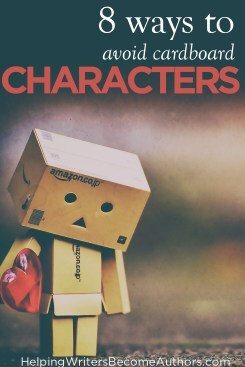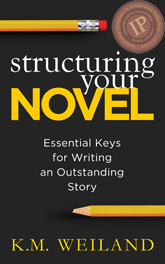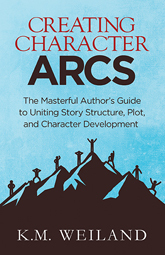8 Ways to Avoid Cardboard Characters (and Plot Contrivances While You’re At It)
 “The plot was contrived, and the characters were cardboard.” Ouch. That’s about as bad as it can get when it comes to negative story reviews. It’s also perhaps one of the most common complaints audiences have about stories. Certainly, it’s one that irritates me the most! Here’s the thing though: cardboard characters often cause plot contrivances—and vice versa. Once you realize this, it can become a little easier to figure out how to identify and avoid cardboard characters (and plot contrivances) in your own fiction.
“The plot was contrived, and the characters were cardboard.” Ouch. That’s about as bad as it can get when it comes to negative story reviews. It’s also perhaps one of the most common complaints audiences have about stories. Certainly, it’s one that irritates me the most! Here’s the thing though: cardboard characters often cause plot contrivances—and vice versa. Once you realize this, it can become a little easier to figure out how to identify and avoid cardboard characters (and plot contrivances) in your own fiction.
This post was inspired by two different western romance novelists I read recently. Neither was perfect, but one I really enjoyed and the other, although better than many, almost invariably compromised her stories with this dreaded tandem of cardboard characters and plot contrivances. What I recognized was that her characters weren’t cardboard until the plot grew contrived—and vice versa, the plot didn’t feel contrived until the characters stopped exhibiting dimensionality in their choices and actions.
Genre stories that follow tight conventions, such as romance and mystery, are often those I see struggling most with this equation. The authors need to hit certain beats and elicit certain emotional responses from readers, but too often they end up hitting the beats in an artificial way that hampers the overall story, killing both realism and resonance. The irony is that emotional resonance is perhaps most necessary in stories of this kind, since the desire for a very specific sort of experience is exactly why readers pick these books up.
Stories that are more varied—such as, say, an adventure story with a romantic subplot or a generational saga with many different slice-of-life aspects—can get away with less-than-perfect emotional resonance here and there due to fact they’re inherently offering audiences a wider selection of experiences. Of course, this spottiness isn’t ideal in any type of story, but those genres with a tighter focus must be all the more vigilant in evoking a genuine response from readers via a genuine presentation of characters.
Regardless what type of story you’re writing, you can always take everything up a notch by paying attention to this all-important link between cardboard characters and plot contrivances. If your story suffers from one, it probably suffers from both. The corresponding good news is that if you fix one, you will probably inevitably fix the other as well.
The Link Between Cardboard Characters and Plot ContrivancesWhat Are Cardboard Characters?As the metaphor suggests, cardboard characters are… flat. And dry. And colorless.
Remember the “blooper” at the end of A Bug’s Life, when one of the ants starts flirting with an attractive extra, only to accidentally knock him over and realize he’s just a cardboard cutout set up to fill out the necessary “cast of thousands” who populated the anthill?

That’s a cardboard character. Attractive on the surface but not much personality—and certainly not much agency.
Cardboard characters are a writer’s mindless robot minions. They do whatever they’re told, no questions asked. Dimensional characters on the other hand push back whenever you’re trying to make them to do something stupid just because it would make for a cool explosion onscreen. “You want me to slo-mo walk away from the exploding building? No way, lady! You think a real secret agent would do that?”
What Are Plot Contrivances?
Structuring Your Novel (Amazon affiliate link)
“Contrivance” means “not genuine.” A contrived plot is one in which the events unfold in a way that simply doesn’t make sense or seems forced. Plot contrivances are the flipside of cardboard characters, so, basically: cardboard plots. These are plots that mechanically hit all the genre beats (although, frankly, not necessarily all the structural beats) as if they were doing a “dot to dot” puzzle. These cardboard plots are particularly obvious when writers try to manufacture a big or exciting scene that lacks proper cause and effect.
Because plot and character are not separate story techniques, but rather two sides of a coin, a contrived plot is almost always the result of a cardboard character who is not showing up to make authentic decisions. If characters aren’t responding to plot events authentically, this will prevent them from, in turn, being able to drive and create an authentic plot. This is most obvious when characters respond to big events without weighing the consequences. For example, someone may choose to make a big (and ultimately even unwise) sacrifice for someone he loves, but not without thoroughly weighing out reasons and options before putting his head in the lion’s mouth.
8 Ways to Avoid Cardboard Characters (and Plot Contrivances)Now that we know cardboard characters equal plot contrivances, and together they equal bad—what can we do about it? After all, the merging of plot and character is a dance. Letting our characters run “authentically” amok with no regard for plot isn’t much better than making the characters mindless servants to the plot events we’re intent on creating.
Here are eight things to keep in mind in order to avoid both cardboard characters and plot contrivances.
1. Learn the Structure of Character Arc, Then Sync It With Your Plot
Creating Character Arcs (Amazon affiliate link)
Writers sometimes worry that adhering too closely to story structure will cause their plots to become contrived, or at least formulaic. And this can be true if the writer is trying too hard to follow the form without understanding the function. One of the best ways to prevent a contrived plot while also deepening character is to study how the shape of a strong character arc syncs up with plot structure—then let the character arc drive the plot. When you do this, your authorial questions become less about “what I can make happen here?” and more about “what would my character do here?”
2. Assign Character Attributes, Then See What HappensAlthough writing a novel is almost inevitably an exercise in discovering your character, it’s usually best if you can start with a sense of at least a few strong attributes for each character. Contrasting attributes are especially juicy. For instance, maybe you choose the attributes of “generosity” and “cynicism,” or “cheerfulness” and “obstinacy.” Then just make sure those attributes are showing up in each scene. This can admittedly complicate your plotting since sometimes it would be a lot more convenient to the plot if the character were “hopeful” or “cooperative” instead of “cynical” and “obstinate.” But if you adhere to your character’s personality as authentically as possible, she will lead you to some interesting plot situations.
3. Don’t Assign Character Attributes, Then Focus on That ExclusivelyHowever, the caveat for the above section is that you must let your character’s attributes develop naturally. You don’t want your story to end up sounding like you’re beating a drum with just one stick. If you decide your character is cheerful, but that’s all he is, he will of course end up being one-dimensional.
This is one reason it’s so helpful to choose contrasting attributes. How will the character balance an easygoing cheerfulness against his own immovable nature? Although you will almost certainly want to create a likable character, make sure you’re balancing attractive qualities with challenging ones. Romance leads who are all charm and gorgeousness are just as cardboard-y as action leads who never lose a fight or never suffer long-term consequences from their injuries. Those aren’t people; they’re stereotypes. And stereotypes can’t drive a plot.
4. Watch Out for Unnecessary Naivety or IgnoranceIn order for simplistic (or just plain unrealistic) plots to work, writers sometimes resort to characters who can’t seem to see the forest for the trees. At best, they might conveniently need everything explained to them—so authors then have a chance to explain to the readers. Worse is when characters can’t seem to draw simple or obvious conclusions from the available clues—so the writer can then further draw out false suspense or inveigle the character into doing some cool plot thing that, if only he saw the writing on the wall, he would never do.
Naive female leads in romances often strain the bounds of credulity, but so do action heroes who are supposed to be legendary but who seem to lack even the most basic understanding of strategy or defense. Sometimes these attributes can be authentic characteristics, but too often they are just contrivances used to create plot dynamics that simply wouldn’t be possible if the characters were acting more realistically.
5. Avoid Emotional Outbursts With No ConsequencesEmotional outbursts are the stuff of fiction. Proclamations of love in the rain. Furious rages and barroom brawls. Great suffering and great joy. It’s all good popcorn catharsis. Audiences love larger-than-life emotions. What audiences don’t love, however, is when the author uses plot contrivances to maneuver cardboard characters into emotional outbursts just for the sake of the outburst.
First off: See Point #4 above. Most people in real life don’t burst out with their emotions in dramatic or unusual (for them) ways without true incitement. This is because, according to the degree a person is socially aware and emotionally intelligent, he will realize that an emotional display of any kind is a cause that will elicit an effect.
Which brings us to second off: Please, pack your story with emotionally dramatic scenes. They’re my favorite. But make sure those emotions don’t exist in a vacuum. Whether it’s a proclamation of love or a display of temper, your character’s expression of himself should elicit realistic responses (aka, consequences—which don’t always have to be “bad”) from other characters.
6. Focus on Motive Rather Than OutcomeStories get over-weighted onto the plot side of the balance when writers focus more on the outcome of a character’s actions rather on the character’s motive for that action. This isn’t to say the outcome isn’t important, but if you’re cramming your character into a showdown scene just because you happen to want a showdown in your story, that may end up feeling contrived. But still… you want that showdown!
So how can you weave it into your story in a way that feels authentic? The answer is to focus on the setup to the scene. What would authentically motivate this character to engage in a showdown? For that matter, ask yourself, “What would authentically motivate you?” Even if your personality is wildly different from your character’s, if you find there’s no way under the sun you would ever do that same action with so little motivation, then think about whether maybe your character’s inner development needs a little more work.
7. Never Bend Character to Fit PlotThis one can get tough. Plots are sprawling and often unwieldy things, and even the best writers can struggle to get them to run in tandem with their characters. Admittedly, sometimes exceptions must be made, in which characters do certain things that might not make 100% sense. This should be done seldom and only with a great deal of caution and sleight of hand, so hopefully readers neither notice nor mind.
Most of the time, however, a character should be respected like a real-live human being—and not forced to do something she doesn’t want to do. That is, she shouldn’t be forced by you, the author. It’s a different proposition if the story, via the other characters, are messing with her day.
And that’s the whole point: throw whatever plot events you want at your characters but make sure they are reacting to them in ways that are unique and realistic to themselves. Your characters may have no choice about what happens to them; sometimes they may not even have a choice about what they do in response; but they should always have a choice about how they feel and rationalize about what happens.
8. Choose Authentic Character Reactions Over Dramatic OnesPlot contrivances usually occur because the author is looking for drama instead of realism. The two are not incompatible. In fact, the best drama is often the kind that emerges from the most realistic situations. Let’s say your character does something heroic—like turn himself in for a crime he didn’t commit in order to protect someone else. That’s super dramatic, right?
Now, whether or not it’s also realistic and authentic will depend on how you play it out. If the character walks to his doom with chin held high, misty-eyed with his own martyrdom, unflinching in the face of a greater good—or if he insists, even in the face of reason, that this is the only choice—that’s just melodramatic. But if this same character spends sleepless nights agonizing over his decision and searching out every other possible alternative before taking the hit—not only is that much more realistic, it’s also much more dramatic. It feels real, so it has resonance. Where there’s resonance, there aren’t likely to be any cardboard characters or contrived plots.
Wordplayers, tell me your opinions! What is your top trick to avoid cardboard characters and plot contrivances? Tell me in the comments!Click the “Play” button to Listen to Audio Version (or subscribe to the Helping Writers Become Authors podcast in Apple Podcast or Amazon Music).
___
Love Helping Writers Become Authors? You can now become a patron. (Huge thanks to those of you who are already part of my Patreon family!)The post 8 Ways to Avoid Cardboard Characters (and Plot Contrivances While You’re At It) appeared first on Helping Writers Become Authors.




